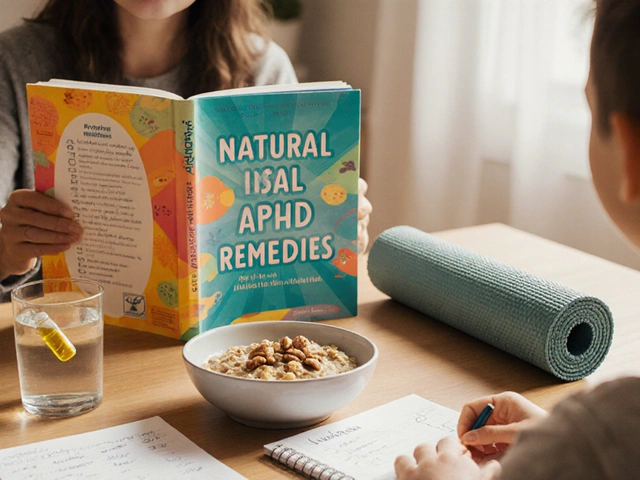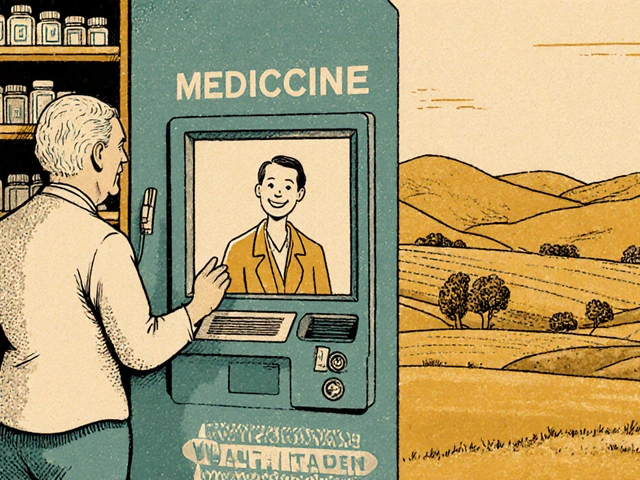You’re in the middle of your workday, staring at a computer screen, when a blinding pain crashes into your head out of nowhere. Your boss’s email becomes gibberish, fluorescent lights feel like torture, and every sound turns up the agony. Migraines are brutal. Yet, with so many prescription options today—Imitrex, Ubrelvy, Nurtec, and others—it makes you wonder which one really gets the job done when you’re desperate for relief.
Understanding Acute Migraine Medications: How Do They Work?
Migraine science has evolved from "just take aspirin and lie in a dark room" to very specific, science-backed treatments. Most acute migraine medicines fall into a few main categories, each with its own way of calming that overactive brain wiring.
Triptans, like Imitrex, have been go-tos since the 90s. They work by binding to serotonin receptors in brain blood vessels, tightening them up, and stopping those vessels from swelling painfully. This means the throbbing pain—and annoying symptoms like light and sound sensitivity—dials back, sometimes within an hour. Imitrex, or sumatriptan, started a revolution here. Wanna dig deeper? Check this breakdown of Imitrex migraine medicine for all the ins and outs, including safety.
The new kids on the block include gepants (Ubrelvy, Nurtec) and ditans (Reyvow). Gepants zero in on calcitonin gene-related peptide (CGRP) receptors, dialing down a key neurochemical that goes wild during a migraine attack. Unlike triptans, they don’t mess with blood vessels, making them a safe bet for folks with heart risks.
Ditans, like Reyvow, target yet another pathway—the serotonin 5-HT1F receptor. They're unique because they treat migraine pain without constricting blood vessels. It’s a big deal especially if your cardiologist warned you off triptans.
NSAIDs (like naproxen and ibuprofen) and simple painkillers (acetaminophen) still get lots of use, especially if symptoms aren’t too hardcore. Caffeine combos and anti-nausea meds often join the party—sometimes in special all-in-one pills.
Here’s a quick look at how the most-used acute migraine pills work:
| Medicine | Main target | Works for | Avoid if |
|---|---|---|---|
| Imitrex (Sumatriptan) | Serotonin 5-HT1B/1D receptor | Most moderate-severe migraines, with or without aura | Heart disease, stroke risk |
| Ubrelvy (Ubrogepant) | CGRP receptor | Quick-acting relief, good for those with heart risks | Severe liver issues |
| Nurtec ODT (Rimegepant) | CGRP receptor | Mild-moderate attacks, prevention option | Serious liver/renal disease |
| Reyvow (Lasmiditan) | Serotonin 5-HT1F receptor | When triptans aren’t an option | Driving soon after dose |
| NSAIDs (Naproxen, Ibuprofen) | Pain & inflammation blocks | Mild migraines, combo therapy | Ulcer, kidney trouble |
As one neurologist put it,
“Migraine is more than just pain—it’s a complex brain storm. The most effective medicine is the one timed right, for the right patient.”
Imitrex: The Backbone of Migraine Rescue
Imitrex—better known by its generic name sumatriptan—has been a lifeline since 1992. For millions, it was the first time a prescription actually ended an attack, not just dulled it. You’ll find Imitrex in tablets, nasal sprays, and even an injectable pen for those who need lightning-quick relief.
The big win with Imitrex? It kicks in fast—nasal spray and injections act in 15–30 minutes. Plus, it’s very predictable if you catch the migraine early, before the pain blows up. The tablet is no slouch either, usually working within an hour. These stats are why it’s still a go-to after three decades.
But there’s a flip side. If you have certain heart problems, a history of stroke, or uncontrolled high blood pressure, doctors steer clear—triptans may squeeze blood vessels not just in the head but the heart. Side effects like chest tightness, tingling, or mild drowsiness can happen, usually fading in an hour or so.
Here's a tip: drink a glass of water with your Imitrex pill and keep quiet for 30 minutes. That combo can help it work better and faster, according to real-world reports. If you tend to vomit during migraines, try the nasal spray or injection version instead. Timing matters—experts suggest you take your dose at the very first hint (rather than waiting until pain is severe) for best results.
Still on Imitrex after years? Don’t sweat it. Data shows long-term users don’t have increased triptan side-effects or rebound headaches if they stick to approved limits—usually no more than 2 doses in 24 hours, and not more than 9 days per month.
If you ever wondered if it’s habit-forming, good news: there’s zero withdrawal, so you don’t need to worry about addiction here.

Ubrelvy and Nurtec: New-Gen CGRP Blockers Changing the Game
Ubrelvy (ubrogepant) and Nurtec ODT (rimegepant) showed up just in the last few years, and a lot of migraine sufferers have switched over. Why? They target CGRP—a molecule proven to shoot up during a migraine—without playing with blood pressure or causing major vascular squeeze. This makes them safer for folks who can’t take triptans, and for those who found older meds just didn’t cut it.
Ubrelvy is a pill you take right as the attack starts. You can repeat the dose a couple hours later if needed. People rave about less "medication hangover"—you’re not left foggy or groggy. Most users feel relief in about two hours. Its main side effects: mild nausea or drowsiness, but overall it’s super well-tolerated.
Nurtec comes as an orally dissolving tablet (ODT)—just pop it on your tongue, anywhere, no water needed. That’s awesome during commutes or if you can’t keep pills down. Uniquely, you can use Nurtec both as preventive (taken every other day) and for rescue (when an attack strikes). Research published in JAMA Neurology showed up to 60% get noticeable pain cutback, sometimes permanently lowering attack frequency.
Neither cause vasoconstriction, so doctors are much more comfortable prescribing them to older adults and those with heart risks. There’s also way less risk of "rebound headaches" compared to stronger painkillers.
If you’re paying out of pocket, here’s a shocker: Ubrelvy and Nurtec are expensive, sometimes several times the cost of generic Imitrex. Good news—insurance coverage is improving, and the big pharma companies have discount cards for most new users, so check before shelling out big bucks at the pharmacy.
Other Migraine Options: When to Try Reyvow, NSAIDs, and Combo Therapies
If Imitrex or CGRP blockers don’t do the trick—or if you’re in the unlucky club who can’t take either—there are more tools in the kit.
Reyvow (lasmiditan) is a ditan, working via totally unique serotonin pathways. It’s non-constrictive on blood vessels, so it’s another lifeline for those with cardiac issues. But heads up: it can make you dizzy or sleepy. The FDA even says not to drive for 8 hours after a dose, so it’s not one you’ll want to pop before an important meeting.
Old-school NSAIDs (like naproxen and ibuprofen) still help if your migraine is mid to mild, or as a booster with other meds. Pairing an NSAID with a triptan or a gepant can crank up relief without adding more side effects, according to current American Headache Society guidelines.
There’s also a grab-bag of combo pills—usually caffeine, acetaminophen, and aspirin. They’re cheap, easy to find, and help some people—but don’t expect miracles if your migraines are severe or frequent. Sometimes, anti-nausea drugs like metoclopramide or ondansetron make a huge difference by letting those pain pills do their job.
Don’t overlook lifestyle changes and daily prevention meds either. Frequent migraines (defined as 4 or more days per month) usually need a plan that goes beyond emergency fixes, with options like beta-blockers, certain anti-seizure drugs, or the once-monthly CGRP antibodies for prevention. But that’s a topic for another article.

Which Migraine Medicine Is Right for You? Choosing Based on Your Real Life
No single migraine therapy works for everyone. Your best bet depends on lots of factors—how fast your attacks come on, what other medical stuff you’re dealing with, even your tolerance for side effects, cost, and convenience.
- Get migraines with a weird aura, or ultra-fast pain and vomiting? A nasal or injectable option may hit the spot faster than any pill.
- Heart disease in the family, or high blood pressure? Stick with CGRP blockers (Ubrelvy, Nurtec) or Reyvow—it’s safer.
- Worried about “medication overuse headache” (the rebound you get from popping too many pills)? Gepants and ditans cause that less than triptans or opioids. Set a reminder on your phone so you don’t end up taking them too often.
- On a tight budget, or waiting for insurance coverage to catch up? Generics like sumatriptan are usually much cheaper than new drugs, but might come with a few more side effects.
- Live far from a pharmacy? Ask if your doctor can prescribe more than one pill or a mix of types—having a backup med handy can save the day.
Doctors often suggest keeping a migraine diary—track what drugs you used, how fast they worked, any side effects, and what else was happening (weather, sleep, stress, food). It sounds nerdy, but you’ll spot patterns your doctor can use to tweak your treatment plan.
By staying open to new meds, paying attention to early warning signs, and tackling migraines head-on with the right tools, you can seriously cut down your pain and get your life back. There’s no magic cure—yet. But armed with knowledge, you’re in a much stronger position than ever before.







Write a comment
Your email address will be restricted to us